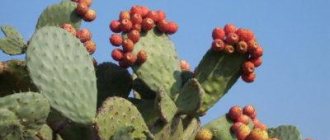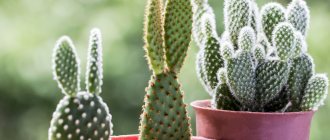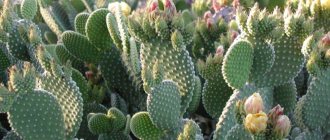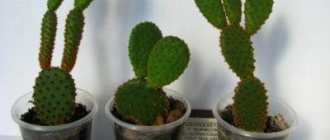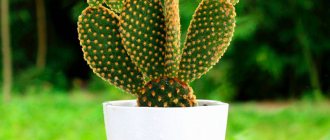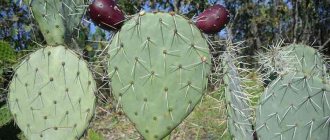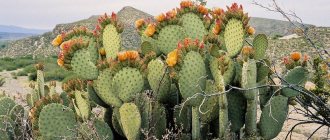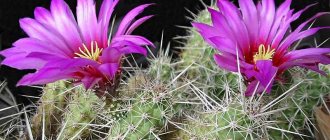Everyone knows this hardy cactus with edible fruits. Prickly pear has flat, succulent shoots of round or oval shape, like ears or flat cakes. They grow from one another at different angles, forming bizarre silhouettes. It happens that a traveler who finds himself in such thickets finds it very difficult to get out of there.
The shoots of prickly pear, like all cacti, have halos - highly modified axillary buds with long sharp spines and bunches of thin spines - glochidia. These villi are very insidious. They have serrations at the ends, like an arrowhead. When they come into contact with the skin, they break off and attach to it, causing irritation and itching.
Prickly pear flowers are solitary, sessile, large and showy, reminiscent of roses. The color is white, yellow, orange, red in different shades.
The fruits are large, juicy and also have spines on the outside. Collect them using thick gloves. The seeds are dark, round, with a hard shell (1).
In tropical and subtropical climates, prickly pear is grown as a food and fodder plant - it is a favorite delicacy of donkeys. Young shoots, cleared of thorns and glochidia, are used as vegetables - fresh, fried, baked, pickled. Large sweet fruits, despite the difficulty of peeling them, as well as the large number of seeds hard as shot, are a delicacy in many countries. They are used to prepare molasses, preserves, raw jam, marmalade, marshmallows, dried fruits, drinks - syrup, juice and wine. On the island of Malta, several companies produce the signature aromatic liqueur Bajtra from prickly pear fruits, which tourists take with them.
Opuntia is not without medicinal properties. The juice of some of its species has a wound-healing effect. Fleshy shoots are used in folk medicine for compresses and in the treatment of burns.
Inside old prickly pear shoots there is non-rotting wood - strong, but at the same time porous and twisted. Candlesticks, handles, and polished jewelry are made from it.
In ornamental gardening, prickly pear is used in landscape compositions in gardens and parks, and also as hedges.
Prickly pears have been known as a houseplant since the beginning of the 18th century, but indoors they bloom reluctantly and only under favorable conditions, and, as a rule, do not produce fruit. However, in winter gardens and wall-mounted heated greenhouses of cottages and country houses, their chances for the full life cycle of shoots are noticeably increased, especially with additional lighting (2).
Young plants usually bloom at 10 years of age or older.
Interesting fact According to ancient legend, the Aztecs, tired of long wanderings in the mountains, stopped on the shore of the beautiful Lake Texcoco and saw an eagle tearing apart a snake on a large prickly pear tree. This was a good sign from the gods and the tribe founded the city of Tenochtitlan here - “Place of the Sacred Prickly Pear” - present-day Mexico City. Now this scene from the legend is depicted on the Mexican coat of arms.
Types of prickly pear
More than 350 species of prickly pear are known in nature. But only a few of them are used in culture.
Opuntia microdasys. Compact branching plant up to 60 cm high for indoor floriculture. The stem consists of oval dark green segments up to 15 cm long with numerous halos-pads of brightly colored glochidia - yellow, red and pearly white (form Albinospina ). The flowers are yellow. The fruits are large red.
Berger's prickly pear (Opuntia bergeriana). Grows up to 1 m. The shoots are elongated, light green, with long yellow spines. It blooms at an early age and profusely. The flowers are orange-red with a green pistil.
White-haired prickly pear (Opuntia leucotricha). The stem fragments are elongated - up to 25 cm. The peculiarity of this species is the long white spines with which all the shoots are densely dotted. The flowers are small, golden yellow.
Opuntia microdasys. Photo: globallookpress.com
Berger's prickly pear (Opuntia bergeriana). Photo: globallookpress.com
Cylindrical prickly pear (Opuntia cylindrica). Photo: globallookpress.com
Indian prickly pear, or fig (Opuntia ficus-indica). Photo: globallookpress.com
Cylindrical prickly pear (Opuntia cylindrica). Plants with cylindrical stems atypical for prickly pears are also called pterocacti.
Indian prickly pear, or fig (Opuntia ficus-indica). The trunk becomes woody at the base. The shoots are olive green in color. Small aureoles contain numerous cream-colored spines. The flowers are bright amber, with a golden tint. In nature it produces a good harvest of very tasty and aromatic fruits.
Gosselin's prickly pear (Opuntia gosseliniana). Plants begin to bloom at 5 years of age. Young prickly pears have reddish shoots, while adults have blue-green shoots with a silvery tint. Only the upper part of the segments is strewn with soft long spines. The flowers are yellow and fragrant.
Description of the cactus
Prickly pear is an angiosperm or flowering plant, succulent, and belongs to the Cactus family. There are just over 300 exotic and colorful species of cacti, 190 of which are classified as Opuntia, the largest genus. Cacti are tree-like, shrubby, creeping and upright growing. Most of them have elongated fleshy stems, similar to leaves, which are both a trunk and shoots; they are called members. On all surfaces, buds with a group of spines and glochidia are developed (look up the meaning of unknown words below). The buds may form branches or flowers. Various types of Opuntia grow as creeping vines, shrubs or tall trees, up to 5-6 meters. During flowering, the cactus blooms bisexual flowers, which are subsequently tied into edible, aromatic, juicy berries. They ripen hard and flat seeds, shaped like cactus leaves. It is a mistake to think that Prickly Pear fruits are fruits.
Berries on Opuntia tomentosa
Caring for prickly pear at home
Prickly pear is easy to grow and adapts well to different conditions. In the summer, it is advisable to move her to fresh air - to a balcony or even to a dacha. During the budding and flowering phase, plants cannot be moved from place to place, as this may cause the flowers to fall off (3).
Priming
For prickly pears, special soils for cacti and succulents or a soil mixture of the following composition are suitable: turf soil, coarse sand, fine crushed stone or expanded clay (2:3:1) with the addition of clay (4).
Lighting
Large, healthy prickly pear plants are formed only under intense light. The ideal place is a south-facing window or close to it, protected from direct sunlight (4).
Photo: pixabay.com
Temperature
In winter, prickly pears are kept at a temperature of 5–15 °C and low soil and air humidity. At higher temperatures, plants stretch and weaken.
In summer, the favorable temperature is 23 – 30 °C, but in principle plants tolerate a wide range of positive temperatures (4).
Humidity
Cacti are exceptionally drought-resistant and even at home can live for a long time without irrigation. Therefore, water them abundantly, but rarely:
- during the growth period - once every 10 - 15 days, depending on the temperature and drying of the soil;
- in winter - once every 20 - 25 days (before the next watering, the soil must dry out; at low temperatures, watering is stopped).
Use only soft, settled water. Watering should be done from a watering can along the edge of the pot so that water does not fall on the plants.
And, oddly enough, prickly pears, and other cacti too, love spraying, since in nature they are covered with tiny drops of dew every morning. Therefore, they need to be sprayed from time to time. You will need a fine spray bottle. The can is filled with warm water (30 – 35 °C), and when sprayed, it cools.
The room where prickly pear grows must be regularly ventilated (4).
Fertilizers and fertilizers
Opuntias, like most cacti, are fed once a month from spring to late summer with complex mineral fertilizers for cacti and succulents or liquid fertilizer for cacti. Organic fertilizers are not suitable for these desert dwellers. Solutions are prepared according to instructions.
In autumn, fertilization is stopped (2).
Trimming
Regular pruning of prickly pear is not required. It is carried out only when the cactus needs help, or to change the appearance of the plant by giving it a beautiful shape or simply reducing it in size. Shoots that have stretched out after winter are often pruned (2).
Bloom
From the beginning of spring (late March-early April) until autumn, flowers with petals in several rows appear on Opuntia. The colors of different varieties are very diverse: pale yellow, golden, cream, bright red and even brown or completely white. As a result of flowering, quickly growing fruits are formed on the branches, the color of which also changes from green to dark red or burgundy as they ripen. The probability of flowering depends not only on climatic conditions, but also on the size of the root system; in cramped pots and with weak roots you will not be able to admire the buds.
You need to try to please Opuntia so that it blooms at home. During the appearance of buds, it reacts critically to changes in the care regimen, and when changing the location in the apartment, turning, decreasing or increasing the volume of water, sunlight or fertilizer, it resets them.
The flowers are bisexual, delicate, fall off or curl when touched carelessly. The developing berries contain spherical seeds with a diameter of 2-6 mm, they are covered with a hard shell, protecting the seeds from the aggressive influence of the external environment. This same “cocoon” complicates seed germination in dry and cool conditions.
Opuntia flowers have the property of proliferation, and due to this, the plant develops, forming stems, in an unpredictable manner and at a high rate.
Proliferation is a phenomenon when actively multiplying plant cells, when dividing, form branches with leaves instead of pistils in the center of the flower.
Reproduction of prickly pear at home
By cuttings. This is the main way. Young shoots are cut off at the point of origin, dried in the shade for 1 - 3 days and planted for rooting, slightly buried, in a sterilized mixture of peat and sand (1:1). The substrate is slightly moistened, and the container with plants is covered with a thin film or non-woven fabric on the frame. The temperature is maintained at 20 °C.
When new buds appear on the cuttings, it is transplanted into a permanent pot.
Seeds. Prickly pear seeds have a very hard shell, so before sowing they need to be scarified - make small cuts with a nail file. Then the seeds are soaked for 30 minutes in a pink solution of potassium permanganate and then another 12 hours in warm water, washing it several times. After such preparation, the seeds are sown in dry soil of the same composition and the container is covered with glass. Next, the substrate is periodically sprayed. The temperature is maintained at 22 °C.
Photo: pixabay.com
The emergence of seedlings can take up to a month and it is important that the seeds do not rot. Grown seedlings dive into small pots (2).
News:
Article date: 05/10/2007Family: Cactaceae (Cactaceae).
Homeland: from the steppe zone of Canada (56°N) to Southern Argentina (except for humid tropical areas). Some species of prickly pear have become naturalized in the Mediterranean, Australia, India, and Russia (Caucasus).
Flowering: rarely indoors.
Height: average.
Light: plants tolerate direct sun well, without shading.
Temperature: in summer, prickly pear is kept at a temperature of 25-35℃. During the dormant period, keep the plant in a cool, dry and bright room; the optimal temperature varies depending on the homeland of the species: For species common in the western and central regions of the United States from -5 to + 5C, some species can be kept in open ground in the Moscow region, they do well overwinter under the snow. For Mexican species, the optimal temperature is from 0 to 5C. For South American species, the optimal temperature is from 7 to 12C.
Watering: in spring and summer, prickly pear is watered abundantly. It is preferable to water from below so that water does not fall on the stems of the plants. Watering in very hot weather should also be reduced and should be done only after 5 pm. In the autumn-winter period, cacti are not watered; they are in a dormant period (the temperature should be 5-10℃), with the exception of young cacti. If in the autumn-winter period the cactus needs watering (a signal for watering can be a loss of turgor (slight subsidence) or an aggravation of the stem topography), then you should very carefully pour a small amount of water on the cactus.
Air humidity: does not play a significant role.
Feeding: during the growing season, once a month with special fertilizers for cacti; during the dormant period, do not feed to avoid unwanted growth.
Dormant period: from October to February. Keep at a cool temperature, water (rarely) only young plants.
Transplantation: Young ones are replanted annually (only if the need arises), adults every 3-4 years. Transplant time is the beginning of the growing season.
Reproduction: seeds and rooting cuttings.
The genus Opuntia Mill. has over 200 species of plants of the cactus family, distributed from the steppe zone of Canada (56°N latitude) to Southern Argentina (with the exception of humid tropical areas). They grow in savannas, caatinga, tropical and subtropical deserts and semi-deserts, pine-juniper forests; some types of prickly pear have naturalized in the Mediterranean (prickly pears appeared in Europe, apparently, back in the 16th century), Australia, India, and Russia (the Caucasus). At one time, prickly pears became a real disaster in Australia, where both the introduction of pests and aerial spraying with pesticides were used to destroy them. Frost-resistant prickly pear species can withstand frosts down to minus 10 ℃.
Prickly pears are cacti with flat, succulent, jointed branches. Erect or creeping shrubs, less commonly trees. On the stems there are modified axillary buds - areoles - with spines and a bunch of easily breaking off thin spines - glochidia. The leaves are small, succulent, subulate, and fall off early. Flowers are solitary, bisexual. The fruits are berry-shaped, in many species, one of which is known as the Indian fig (O. ficus-indica), edible. Unlike other cacti, the seeds are flat with a hard skin.
Prickly pears are of interest to gardeners not only because of the variety of growth forms, but also because of the complete unpredictability of development, because prickly pear shoots sometimes appear where you least expect them. It's hard to resist the temptation to spice up your cacti collection with such amazing plants, even though they sometimes grow too quickly and are very annoying to prick. The fact is that all prickly pears have glochidia - tiny bristles, the curved tips of which can only be seen under a microscope. They sit precariously in the pubescent areolas and dig into the skin even with the most careful touch. It is best to remove glochidia with tweezers or in a soap solution.
You cannot count on the formation of flowers in most tall prickly pears under indoor conditions. But if they grow in large tubs, which can be taken out into the garden in the summer, or are in greenhouse soil, then many round simple flowers with short yellow, orange or red (less often white) petals often appear on the flat lateral segments. The stamens of prickly pears are usually short, and even when touched lightly, they immediately curl. The fleshy berries contain light-colored seeds the size of a lentil grain; their ossified shell complicates the germination of prickly pears in the European climate. Opuntias are characterized by one feature, namely proliferation, i.e. the ability to develop new flowers and shoots from the fruits, but the fruits do not set seeds.
Prickly pear is an ancient Indian plant; depicted in the national emblem of Mexico. Stems contain starch, sugar, protein, vitamin C; can serve as food for animals. Plants are easily propagated vegetatively. In some parts of America, locals eat the fig-like prickly pear fruit, calling the fleshy berries "tuna" and distinguishing them by color (tuna amarilla, tuna blanca, tuna tinta, etc.). Peeling the fruit from the glochidia-studded skin requires considerable manual dexterity, but the Indians easily cope with this task. The fruits of wild prickly pears were also eaten in Spain, where the time of ripening of these berries was celebrated as a kind of folk holiday.
Kinds:
White-haired prickly pear (Opuntia leucotricha DC.). The homeland of the plant is Mexico. This is a white pubescent prickly pear up to 5 meters high. The branches form a beautiful crown. The segments are 10–20 cm long, quite densely strewn with hard white bristles, reaching 8 cm in length in older plants, and yellow glochidia. The flowers are yellow with green stigmas, about 8 cm in diameter. The fruit is spherical, almost white, aromatic, edible. Berger's prickly pear (Opuntia bergeriana FAC Weber ex A. Berger) forms bright light green segments 20–25 cm long, sometimes looking almost angular. The areoles, spaced 2–4 cm from each other, bear yellow, sometimes brownish-yellow spines of varying lengths. Flowering is abundant, the color of the flowers is rich orange-yellow, the stigma is green. This is an undemanding, vigorous plant more than a meter high. Its homeland has not been established, but wild forms are found on the Riviera.
Opuntia major (O. basilaris Engelm. & JM Bigelow) - photo. Homeland: Western Arizona, Southern California, Nevada, Southern Utah. The plant is distinguished by the peculiar coloring of its obovate segments - blue-green or reddish with depressed brownish-pubescent areoles and very few spines. The flowers are pink to carmine red, the pistil is red. It grows quite slowly and does not tolerate waterlogging. This species has a rare cordata with heart-shaped upper segments, as well as a dwarf nana with elongated segments.
Gosselin's prickly pear (O. gosseliniana FAC Weber) - photo - is a fairly famous species. The plant is native to Southern California and Mexico. It grows actively and blooms with beautiful yellow flowers at a young age. The color of the segments is gray-blue-green, while very young ones are reddish. Quite soft spines up to 10 cm long develop mainly from the upper areoles.
Opuntia santa rita (O. gosseliniana var. santa rita) . A dark purple pattern is visible along the edges of the round segments covered with a blue coating and around the areolas. In a sunny, dry place, the colors of the plants become especially bright. This prickly pear, susceptible to waterlogging, is most often grown in grafted form.
Long-awned prickly pear (O. longispina Haw). The prickly pear is native to northwestern Argentina. Its clavate-spherical and yet slightly flattened segments, no more than 3–4 cm long, form chains. On the brownish areoles there are bunches of reddish glochidia, many red marginal spines and one central, thin and long. The flowers are red, wide open. With such a short stature of the plant, its spines, several centimeters long, look very large.
Curassavia prickly pear (Opuntia curassavica (L.) Mill.) - photo - appeared in Europe a very long time ago, its first drawing was made back in 1696. The plant’s homeland is the island of Curacao and the nearest islands to the north of Venezuela. The segments are narrow and long, on small short-haired areoles there are four or more light-colored spines. Even with a gentle touch, the segments break off, which makes it easy for plants to reproduce.
Opuntia brittle (O. fragilis (Nutt.) Haw.). Homeland - southwest and central USA. Its segments - usually round, sometimes flattened, only a few centimeters long - fall off especially often. Small areoles with white descent, spaced 8–12 mm from each other, bear yellowish glochidia and up to four cross-shaped yellow-brown spines up to 3 cm long. The flowers are pale yellow with green stigmas. Or. fragilis var. brachyarthra is distinguished by stronger tuberosity of segments, many spines and small flowers. Prickly pears are winter-hardy in European conditions.
Prickly pear, golden prickly pear (O. microdasys (Lehm.) Pfeiff.). Homeland - Northern Mexico. This plant, well known in indoor floriculture, with beautiful golden-yellow tufts of glochidia on each areola, is quite often found in small collections. The segments are small, rounded, the plant is characterized by short stature. The flowers are golden yellow inside and the style is whitish. The fruit is round, red, berry-shaped.
| O. microdasys |
The mighty prickly pear (Opuntia robusta HL Wendl. ex Pfeiff.) fully lives up to its name. The plant's homeland is Central Mexico. The diameter of the thick, almost geometrically round segments, covered with a gray coating, can reach 30–40 cm; widely scattered areoles are sometimes equipped with yellow or whitish spines. The flowers are yellow, reddish on the outside.
Opuntia retrorsa Speg. The homeland of prickly pear is Northern Argentina. It was named for its obliquely spaced spines, which give this graceful plant a very distinctive shape and make it easier to identify the species. The lanceolate, flat green segments are more or less narrowed towards the tips, under the areoles, which are far apart from each other, there are dull purple spots, reminiscent of a cast shadow. Each areole has three spotted spines (two very short, the central one about 2 cm long), initially spaced and later bent downwards. The flowers are yellowish.
Opuntia tomentosa Salm-Dyck is a vigorous plant and is therefore readily used by cactus growers as a rootstock. Homeland - Central Mexico. The elongated dark green segments, 10–20 cm long, are densely covered with soft pubescence; their velvety texture makes it easy to identify this species. There are almost no areoles, short white spines rarely develop. Fiery red flowers, 4–5 cm long, appear only on old plants.
Pink-flowered prickly pear (Opuntia rhodantha K. Schum.). The homeland of prickly pear is western Colorado, Nebraska, Utah, Arizona, California, USA. Winter-hardy in European conditions, it is one of the best decorations for alpine hills. Caring for it is rewarded by the development of glossy brown-red plants with very beautiful spines and the appearance of beautiful rose-like flowers that bring special joy. Quite thick and tuberculate segments, almost ovoid in shape, medium-sized, but strongly branched. The areoles have from one to four radiate spines of varying lengths. Purple-pink flowers with green stigmas are the same length and width.
Opuntia sulphurea Gillies ex Salm-Dyck. The plant's homeland is Western Argentina. This prickly pear gets its name from the sulfur-yellow color of its flowers. It grows greatly in width, but no more than 30 cm in height. The segments are quite small, thick, green (often with a reddish tint), and highly tuberous. The spines are few, usually curved, brownish or white with brown tips. This species is easily identified by its tuberous segments. In the hildmannii variety, the segments are thicker and larger, the areoles are more widely scattered, and the spines are few, sometimes with a reddish tint. The species of the plant can be determined by the bumpy pads on which the areoles sit. This variety is inferior to the standard form in terms of growth activity and is susceptible to waterlogging.
Opuntia compressa auct. Homeland - southern states of the USA. It forms creeping shoots with almost round or ovoid segments of bright green color. The spines are absent or are found sporadically at the ends of the shoots. A typical feature of the species is rounded-pointed green leaves several millimeters long. When grown outdoors, this prickly pear easily produces pale yellow flowers that are 5cm in diameter.
The creeping prickly pear (Opuntia humifusa (Raf.) Raf.), growing in the southern United States, is much larger than other species. It has dark green segments, large areoles, brown glochidia, large areoles with three whitish spines, the tips and base of which are often reddish, and long, erect leaves. The flowers are yellow, sometimes with a red throat. With the right choice of location, these prickly pears can overwinter in open ground in European conditions. Feral Or. compressa is sometimes found in the Southern Alps and Dalmatia.
Scher's prickly pear (Opuntia scheerii FAC Weber) is one of the most beautiful prickly pears, although it is too large for small home collections. The homeland of the plant is Mexico. Densely spaced areoles bear needle-shaped yellow spines 1 cm long, corymbose hairs and brown glochidia. The flowers are pale yellow, salmon pink when blooming, the pistil is green.
Plant care:
In nature, prickly pear grows on mountain slopes, in semi-deserts and steppes, and is accustomed to strong temperature changes during the day. In her rooms, it is advisable to provide her with good lighting and fresh air. Prickly pear prefers bright direct light, without shading. Cacti receive the best lighting when kept open, on south-eastern and southern balconies and windows, somewhat worse - on eastern and western ones. If the plant is kept in a northern window, then due to lack of light it loses its natural appearance, stretches out and does not bloom (therefore, artificial lighting is necessary in the summer). If there were few bright days in the autumn-winter period, then in the spring, when exposing the plant to the open air, it should be gradually accustomed to direct sunlight in order to avoid sunburn. During the appearance of buds, you should not change the position of the plants relative to the cardinal directions, as this can lead to their falling off.
In summer, prickly pear is kept at a temperature of 25-35℃. It can be exposed to the open air; If this is not possible, it is advisable to ventilate the room. In autumn, it is necessary to gradually reduce the air temperature in order to provide the cacti with a period of rest. During the dormant period, prickly pear is kept in a cool, dry and bright room, the optimal temperature varies depending on the homeland of the species: For species common in the western and central regions of the United States from -5 to + 5C, some species can be kept in open ground in the Moscow region, they do well overwinter under the snow. For Mexican species, the optimal temperature is from 0 to 5C. For South American species, the optimal temperature is from 7 to 12C. At higher temperatures, plants stretch out. It is very important to observe the temperature regime in the autumn-winter period, since warm air, coupled with a lack of light, prevents the prickly pear from entering a dormant period and can lead to deformation of the plant.
In the spring and summer, prickly pear is watered abundantly, but so that the earthen lump dries out completely between waterings. It is preferable to water from below so that water does not fall on the stems of the plants. As a result, the pores become clogged with calcareous formations, breathing is impaired, and suberization begins. Watering in very intense heat should also be reduced; it should be done only after 5 pm, because... The life processes of cacti are suspended during the day, and in the evening they gain strength. In the autumn-winter period, cacti are not watered; they are in a dormant period (the temperature should be 5-10℃), with the exception of young cacti. If in the autumn-winter period the cactus needs watering (a signal for watering can be a loss of turgor (slight subsidence) or an aggravation of the stem topography), then you should very carefully pour a small amount of water on the cactus. If it is kept at a low temperature (5-12℃), then it should be gradually increased above 12℃, since at a temperature of 10℃ and below the plant is not able to absorb water, and such watering only causes harm, or even death. When the growing season begins, the first watering is done carefully and with a small amount of water. Water for irrigation must be well settled and preferably acidified with citric acid (at the rate of 0.5 teaspoon per 7 liters of water).
The plant can be fed with the onset of the growing season once a month with special fertilizers for cacti; during the dormant period, do not feed it to avoid unwanted growth. It must be remembered that in mineral fertilizers the level of nitrogen should be less than other elements, since excess nitrogen can cause root rot; normally, you can adhere to the following ratio: nitrogen (N) - 9, phosphorus (P) - 18, potassium (K) - 24. It is better to refrain from using organic fertilizers.
It is impossible to indicate the exact time for replanting, since it depends on the geographical location, on annual fluctuations in climatic conditions, on where your collection is located - on a fenced-off window sill, in a window greenhouse or in a greenhouse, and even on the geographic orientation of your window. You yourself must catch the moment when your pets “pour” and begin to grow. This will be the best time for transplantation. You just need to take into account that if the plant has buds, then it can be replanted after flowering. Young ones are replanted annually only if the need arises, adults every 3-4 years. Before transplanting cacti, the soil in the pot must dry; they are transplanted from dry soil to dry soil. Watering after transplantation can only begin after 5-7 days; during this time, it is better to place the cactus in a shady place.
The soil must be nutritious, water- and breathable with a slightly acidic reaction (pH 4.5 - 6). The usual mixture for cacti (loose, mineralized) is not suitable; it slows down the growth of prickly pears. You can use a mixture of leaf, turf soil, weathered clay and sand (2:1:1:1) with the addition of charcoal (for young plants) or old plaster (for old ones).
Prickly pear is propagated by seeds and rooting cuttings. The method of seed propagation is poorly developed. The seeds germinate slowly and unevenly, but the seedlings are large and viable.
Propagation by seeds is quite troublesome, but an interesting activity. The seeds are sown in early March in a sterilized substrate consisting of leaf soil (completely rotted), washed river sand and finely crushed charcoal in a ratio of 1:1:1/2; good drainage is required. Before planting, seeds are disinfected for 10 minutes in a weak solution of potassium permanganate. Since prickly pear seeds have a hard shell, it is necessary to mechanically break the shell. Mechanical damage to the shell is done with a file, sandpaper on a soft cloth or wrapping paper and grinding with coarse sand or gravel. The temperature is maintained within 20C, constantly sprayed and ventilated. After the seeds germinate, they are planted in containers of appropriate size, and the next replanting takes place next year. Only when the seedling reaches 2 years of age can it be cared for like adult plants, but it must be gradually accustomed to the conditions of care. Young seedlings need good lighting, but direct sunlight should be avoided.
Rooting of cuttings is carried out from spring to mid-summer; this is the best time for rooting. After separation, it is dried for 24 hours. After this, they are rooted in sterilized moistened sand with bottom heating. Cover with a glass cover, maintain the temperature at 20℃, spray and ventilate regularly. When the cuttings take root, they are planted in the substrate in the main substrate.
Peculiarities:
In indoor culture, prickly pears rarely bloom, perhaps this is due to the fact that under natural conditions these plants reach large sizes; indoors they grow more slowly and are most likely not large enough to flower. It is also likely that there will be no flowering due to care conditions. If buds begin to form on the plant, then you must adhere to the following: Do not move closer to the light; Do not turn; Do not replant; Do not water more often or more abundantly than usual; Do not feed additionally.
Otherwise, the buds will be dropped or degenerate into vegetative shoots (babies).
Precautions: All prickly pears are equipped with glochidia - tiny single-celled hairs with numerous downward-pointing hooks, the tips of which can only be seen under a microscope. Digging into the skin, glochidia cause an extremely painful sensation. They sit precariously in the pubescent areolas and dig into the skin even with the most careful touch. It is best to remove glochidia with tweezers or in a soap solution.
Possible difficulties:
An elongated stem with an uncharacteristic shape: the reason for this may be too warm a “winter” or a lack of light in the summer.
Wrinkled end of the stem, spots of soft rot at the bottom: the cause may be waterlogging of the soil in cloudy or cold weather.
Lack of growth: the cause may be insufficient watering in summer or waterlogging of the soil in winter. A lack of nutrients may also be the cause.
Cork spots on the surface of the stem: the cause may be local pest damage, a wound or hypothermia. Insufficient watering in summer may also be the cause.
Soft brown spots: This may be caused by stem rot; Rot rarely affects well-growing cacti. Cut out the affected area and disinfect the soil with a carbendazim solution. Improve living conditions.
Damaged by: mealybugs, spider mites, scale insects, whiteflies.
Author of the article: Marina Mityaeva
Discuss the article and care on the forum
Cactus family (Cactaceae)
Substrates for desert cacti.
Prickly pear is a common theme with already identified plants.
Share the link
Materials used in the article:
article from Walter Hage's book "Cacti".
Cacti and other succulents: Directory / D. Beffa; Per. from Italian I.V. Artyushina; Ph. K. Dani. - M.: AST Publishing House LLC: Astrel Publishing House LLC, 2003. -335, [1] p.: ill.
- photo
- photo
- photo
https://www.gargamel-cactus.com/photos/album16/Opuntia_curassavica2 - photo
- photo
Transplanting prickly pear at home
Young prickly pears are replanted every year or every other year, adults - once every 4 - 5 years, as they grow or when the substrate is depleted.
Replanting cacti is much easier than other indoor plants; their roots are easily freed from the soil and their survival rate is usually high.
The best time to transplant is at the end of winter. Watering should be stopped a week in advance. The diameter of the new pot should be 2–3 cm larger than the previous one. Plants are buried to the level of the root collar.
Transplantation can be alternated with transshipment into larger containers while preserving the earthen clod.
Transplanted plants begin to be watered after 10 – 12 days (5).
Prickly pear diseases
Cacti are more susceptible to physiological - non-infectious diseases that develop under unfavorable conditions for plants. Stale air in a poorly ventilated area, high humidity in the air and soil, especially at low temperatures, contribute to the emergence and spread of diseases.
Main signs of ailments:
Brown spots on shoots. The reason is excessive watering.
The affected segments are cut down to healthy tissue and treated with crushed coal.
Shriveled leaves. This usually occurs due to lack of light or excess moisture.
It is recommended to move the plant to a brighter place and adjust watering.
Stopping growth. A consequence of excess moisture in winter and (or) deficiency of nutrients, including microelements.
Photo: pixabay.com
Proper watering and regular fertilizing will correct the situation.
Weakened plants can become infected with fungal diseases: blight (wet rot) and fomoz (dry rot). To protect against them, fungicides are used - Bordeaux mixture, Fundazol, Polychom (3).
Prickly pear pests
The main pests of prickly pear are spider mites and mealybugs; scale insects also readily settle on the shoots, and nematodes on the roots. Regular inspection of plants will allow you to immediately notice the appearance of pests and take action.
Spider mite. It multiplies quickly in dry, poorly ventilated areas. It feeds on plant cell sap, mainly on young shoots. With severe damage, prickly pears stop growing, and the color of the shoots changes to yellowish or reddish.
Acaricides are suitable for treatment: Neoron, Sunmite, etc. - according to the instructions.
Mealybug. When these small insects accumulate, the cacti seem to be sprinkled with flour. White lumps of oviposition are also clearly visible.
At the initial stage of infestation, insects and eggs can be washed off with a damp brush. Severely affected plants are treated with insecticides - Actellik, Fufanon (6), etc. and covered with plastic wrap for a day.
Against nematodes, the soil is watered twice, with an interval of 7–10 days, with nematicides (Vidat, Nematofagin-Mikopro, etc.), according to the instructions. Scale insects are mainly removed mechanically, and the shoots are then washed with a weak solution of potassium permanganate (3).
Interesting fact
In the recent past, in Mexico, entire prickly pear plantations were grown to breed the hairy aphid - cochineal, from which they obtained a valuable crimson dye - carmine. With the advent of synthetic dyes, the cultivation of cochineal has sharply decreased, but natural carmine is still used in the food and perfume industries, as well as in biochemical research and for staining histological preparations for study under a microscope.
Interesting facts about the prickly pear cactus and its history
Interesting facts about the prickly pear cactus
According to the legend of the Indian peoples of Mexico, the city of Tenochtitlan, now called Mexico City, was founded in the place where the sacred prickly pear grew. On a small island, the Aztecs noticed an eagle sitting on a prickly pear, eating a snake. It is this picturesque scene that is depicted on the state coat of arms.
With the development of navigation and navigation, some types of prickly pear were able to spread throughout the world. In the Mediterranean countries, the Canary Islands, South Africa, India, even Australia, the prickly pears brought there acclimatized and settled so widely and densely that they became an integral element of the landscape of these regions
The shape and taste of the fruit have given rise to many interesting names for prickly pear: “Indian fig or fig”, “Indian pear”, “fig cactus”, “prickly pear”, “Indian rice”, as well as “dragon fruit”. The German definition of this plant is “eared cactus”... And these are not all the names...
The fruits of some types of prickly pear contain vitamin C and are eaten as a delicacy. Syrup and jam are made from them. Mexicans make famous alcoholic drinks (liqueur) from prickly pear. In some southern agricultural countries, prickly pear is grown as a hedge and as livestock feed. It is used to prepare medicines and as a cheap biofuel. Prickly pears are bred to produce carminic acid and carmine, a red food coloring.
